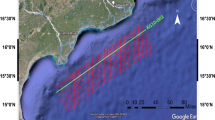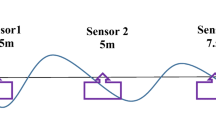Abstract
Taking a study area in Jinzhong Basin in Qixian County, Shanxi Province, as an example, this work performs an intelligent interpretation of ground fissures. On the basis of a complete analysis of the regional geological background in the study area, dip-steering cube operation and median filtering of seismic data were performed using fast Fourier transform to improve the continuity of seismic events and eliminate random noise. A total of 200 stratigraphic continuous sample training points and 500 discontinuous training points were obtained from the processed seismic data. Thereafter, a variety of attributes (coherence, curvature, amplitude, frequency, etc.) were extracted as the input for the multilayer perceptron neural network training. During the training period, the training results were traced by normalized root mean square error (RMSE) and misclassification. The training results showed a downward trend during the training period. The misclassification curve was stable at 0.3, and the normalized RMSE curve was stable at 0.68. When the value of the normalized RMSE curve reached the minimum, the training was terminated, and the training results were extended to the whole data volume to obtain the attribute cube of intelligent ground fissure detection. The characteristics of ground fissures were analyzed and identified from the sections and slices. A total of 11 ground fissures were finally interpreted. The interpretation results showed that the dip angles were 60°–85°, the fault throws were 0–43 m, and the extension lengths were 300–1,100 m in the whole area. The strike of 73% of the ground fissures was consistent with the direction of the regional tectonic settings. Specifically, four ground fissures coincided with the surface disclosed, and the verification rate reached 100%. In conclusion, the intelligent ground fissure detection attribute based on the dip-steering cube is effective in predicting the spatial distribution of ground fissures.
Similar content being viewed by others
References
Chang Qing, Liu Dan, Liu Xiaowen. Ecological risk assessment and spatial prevention tactic of land destruction in mining city[J]. Transactions of the Chinese Society of Agricultural Engineering (Transactions of the CSAE), 2013, 29 (20): 245–254. (in Chinese with English abstract)
Cheng Linlin, Zhao Yunxiao, Chen Liang. Evaluation of land damage degree of mining subsidence area with high groundwater level[J]. Transactions of the Chinese Society of Agricultural Engineering (Transactions of the CSAE), 2017, 33 (21): 253–260. (in Chinese with English abstract)
Chen Peipei, Wu Qiang. Prediction of mining collapse based on neural network[J]. Coal Geology & Exploration, 2001, 29(3):44–47. (in Chinese with English abstract)
Chen Guangming, He Huangsheng, Zhang Deyuan. Application and result of 3D seismic explorition in surveying the ground fissure[J]. Coal Geology & Exploration, 2006, 34(5): 65–67. (in Chinese with English abstract)
Dong Donglin, Wu Qiang, Jiang Zhenquan, et al. Analysis of geological genesis of earth-fissure in Linfen city[J]. Journal of China University of Mining & Technology, 2002, 31(1):34–38. (in Chinese with English abstract)
Du Wenfeng, Peng Suping, Shi Suzhen. The spatial distribution characteristics of ground fissures based on 3D seismic exploration[J]. Chinese Journal of Rock Mechanics and Engineering, 2016, 35(4): 778–783. (in Chinese with English abstract)
He Hongqian. Study on the Formation Mechanism of Ground Fissures in Weihe Basin[D]. Xi’an: Chang’an University, 2011. (in Chinese with English abstract)
Hu Zhenqi, Wang Xinjing, He Anmin. Distribution characteristic and development rules of ground fissures due to coal mining in windy and sandy region[J]. Journal of China Coal Society, 2014, 39(1): 11–18. (in Chinese with English abstract)
Hu Zhenqi, Li Ling, Zhao Yanling, et al. Morphology development evaluation of reclaimed soil in coalmining subsidence areas with high groundwater levels[J]. Transactions of the Chinese Society of Agricultural Engineering (Transactions of the CSAE), 2013, 29(5): 95–101. (in Chinese with English abstract)
Hu Zhenqi, Long Jinghua, Zhang Ruiya, et al. Damage characteristics and reclamation planning for coalmining subsidence in old multiple seam mining area in northeast China[J]. Transactions of the Chinese Society of Agricultural Engineering (Transactions of the CSAE), 2017, 33(5):238–247. (in Chinese with English abstract)
Li Shixiong, Li Shouding, Gao Hongqiang. The distribution characters and origin mechanics of ground fissures hazard in Hebei plain[J]. Journal of Engineering Geology, 2006, 14(2): 178–183. (in Chinese with English abstract)
Li Jing, Zipper Carl E., Li Song, et al. Character analysis of mining disturbance and reclamation trajectory in surface coal-mine area by time-series NDVI[J]. Transactions of the Chinese Society of Agricultural Engineering, 2015, 31(16), 251–257. (in Chinese with English abstract.
Li Mingming, Ding Zhongyi, Bian Xiaohong, et al. Influence assessment of the coal mining on the ecological service functions of agro-ecosystems in the mineral zone[J]. Chinese Journal of Soil Science, 2012, 43(6):1311–1317. (in Chinese with English abstract)
Lu Quanzhong, Zhao Fukun, Peng Jianbing, et al. Overview on rupture propagation studies of buried ground-fissures[J]. Journal of Engineering Geology, 2013, 21(6): 898–907. (in Chinese with English abstract)
Li Yuanqiang. Waveform characteristics of GPR ground fissure exploration[J]. Geophysical and Geochemical Exploration, 2012, 36(4): 651–654. (in Chinese with English abstract)
Liu Wei, Chen Xuehua, He Zhenhua, et al. Neural network gas chimney identification based on steering cube[J]. Oil Geophysical Prospecting, 2012, 47(6): 937–944. (in Chinese with English abstract)
Meng Lingchao. Study on the Formation Mechanism of Ground Fissures in Shanxi Fault Basin[D]. Xi’an: Chang’an University, 2011. (in Chinese with English abstract)
Peng Jianbing, Fan Wen, Li Xian, et al. Some key questions in the formation of ground fissures in the Fen-Wei basin[J]. Journal of Engineering Geology, 2007, 15(4): 433–440. (in Chinese with English abstract)
Peng Jianbing, Chen Liwei, Huang Qiangbing, et al. Large-scale physical simulative experiment on ground-fissure expansion mechanism[J]. Chinese Journal of Geophysics, 2008, 51(6): 1826–1834. (in Chinese with English abstract)
Qiao Jianwei, Peng Jianbing, Deng Yahong, et al. The study on basic characteristic of earth fissure in Linfen Basin[J]. Journal of Engineering Geology, 2015, 23(5): 856–865. (in Chinese with English abstract)
Sun Qi, Bai Zhongke, Cao Yingui, et al. Ecological risk assessment of land destruction in large open-pit mine[J]. Transactions of the Chinese Society of Agricultural Engineering (Transactions of the CSAE), 2015, 31(17), 278–288. (in Chinese with English abstract)
Tian Xiaosong, Zhou Chunrong, Tan Xianlong, et al. Discussion on the land destruction based on the subsidence prediction in the rock saltmining area[J]. Journal of Safety and Environment, 2015, 15(2): 92–98. (in Chinese with English abstract)
Wang Jingming, Wang Chunmei, Liu Ke. Progress in ground fissures and its hazard research[J]. Advance in Earth Science, 2001, 16(3): 303–312. (in Chinese with English abstract)
Wang Shidong, Liu Yi. Evaluation of the degree of land destruction in mining areas using improved fuzzy comprehensive evaluation method[J]. Chinese Journal of Eco-Agriculture, 2015, 23(9): 1191–1198. (in Chinese with English abstract)
Wang Shuaihong, Sun Taisen, Zhou Wei, et al. Reclamation of coal mine subsidence area in loess hilly and gully regions[J]. Transactions of the Chinese Society of Agricultural Engineering (Transactions of the CSAE), 2011, 27 (9): 299–304. (in Chinese with English abstract)
Xue Yongsen, Yun Wenju, Zhang Fengrong. Security evaluation and measures of land arrangements in Sichuan seismic region[J]. Transactions of the Chinese Society of Agricultural Engineering (Transactions of the CSAE), 2010, 26(5): 288–294. (in Chinese with English abstract)
Xu Xiaolian. Probe into geofracture 3D seismic prospecting data digital processing technology[J]. Coal Geology of China, 2010, 22(9): 64–67. (in Chinese with English abstract)
Yun Huixing, Zhang Yongbo. Genesis analysis on ground fissures in Taigu, Shanxi province[J]. Journal of Shanxi Agricultural University: Natural Science Edition, 2008, 28(3): 362–365. (in Chinese with English abstract)
Yan Jiaping, Chen Xiaoyang, Cheng Fangkui, et al. Effect of soil fracture priority flow on soil ammonium nitrogen transfer and soil structure in mining area[J]. Transactions of the Chinese Society of Agricultural Engineering, 2018, 34(2), 120–126. (in Chinese with English abstract)
Yang Ruizhao, Li Yang, Pang Hailing, et al. 3D seismic chimney detection technology based on dip steering and its application on Buir Sag of Hailar Basin[J]. Geoscience, 2013, 27(1): 223–230. (in Chinese with English abstract)
Zhang Zhongbin, Peng Xinhua. A review of researches on soil cracks and their impacts on preferential flow[J]. Acta Pedologica Sinica, 2015, 52(3): 477–488. (in Chinese with English abstract)
Author information
Authors and Affiliations
Corresponding author
Additional information
The study was supported by Open Fund of State Key Laboratory of Coal Resources and Safe Mining(Grant No. SKLCRSM19ZZ02) and the National Natural Science Foundation of China (No. 41702173).
Shi Suzhen is an associate professor and master supervisor at China University of Mining and Technology (Beijing). Her main work is seismic data interpretation and inversion. Her contact information is State Key Laboratory of Coal Resources and Safe Mining, China University of Mining and Technology (Beijing), 11 Ding Xueyuan Road, Haidian District, Beijing 100083, China. Her email address is ssz@cumtb.edu.cn.
Rights and permissions
About this article
Cite this article
Shi, SZ., Gu, JY., Feng, J. et al. Intelligent identification method for near-surface ground fissures based on seismic data. Appl. Geophys. 17, 639–648 (2020). https://doi.org/10.1007/s11770-020-0877-8
Received:
Revised:
Published:
Issue Date:
DOI: https://doi.org/10.1007/s11770-020-0877-8




